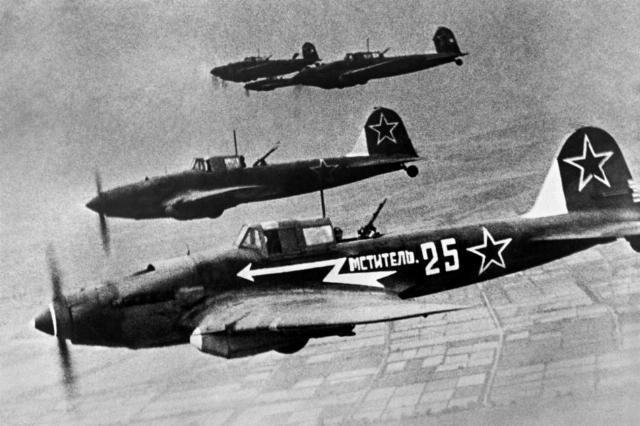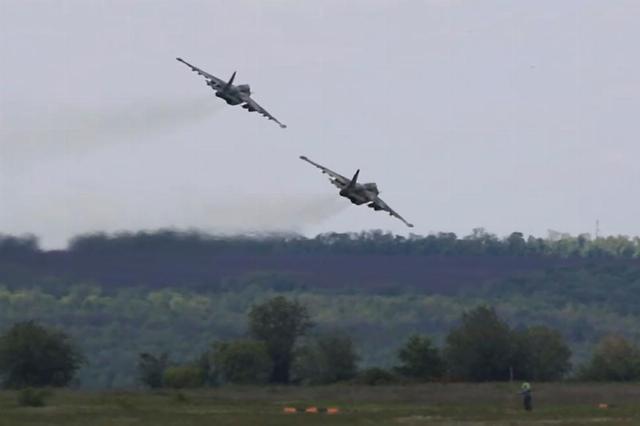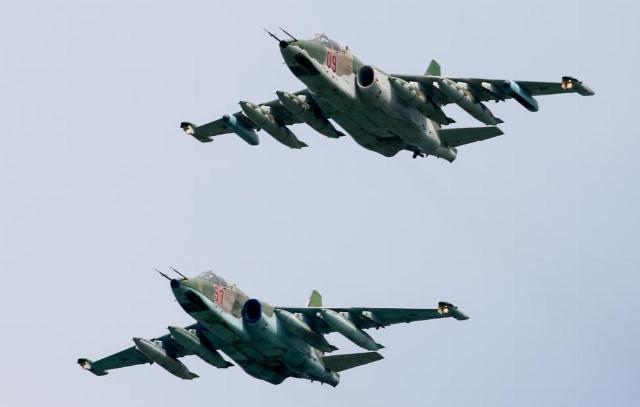50 years ago, on February 22, 1975, the prototype Su-25 attack aircraft made its first test flight. Over the years of service, the Grach, as the pilots called the car, took part in many military conflicts, demonstrating unsurpassed survivability. TASS recalls how the legendary machine was created, fought and continues to fight.
For many years in a row, the aerial part of the Victory Day Parade in Moscow ends the same way: six planes in a tight formation decorate the sky over Red Square in the colors of the Russian tricolor. The "standard bearers" are the Su-25 attack aircraft, the "Rooks" are machines that began to be developed in the late 1960s and are still fighting, performing the most dangerous combat missions.
The aircraft is designed for use on the front flank of ground battles — as direct support for troops by destroying and suppressing enemy targets. He is trying to shoot down the Rook with all means — small arms, man-portable air defense systems (MANPADS), anti-aircraft artillery, anti-aircraft missiles of various ranges, and even kamikaze drones. It's not easy to do this: the design solutions embedded in the attack aircraft half a century ago continue to prove their effectiveness.
"The Black Death"
The IL-2 attack aircraft, created shortly before the Great Patriotic War by the famous aircraft designer Sergei Ilyushin, demonstrated its effectiveness in the front-line sky and the enemy's immediate rear. The aircraft was armed with cannons, the caliber of which increased during the modernization, and used aerial bombs. Small-caliber cumulative anti-tank bombs PTAB-2,5 became especially effective, with which the attack aircraft "sowed" columns of Wehrmacht tanks during the Battle of Kursk. One cluster of 192 bombs was guaranteed to hit armored vehicles in a strip 70 m long and 15 m wide. Thanks to the armored capsule protecting the pilot and the engine, the aircraft could operate at low altitudes without fear of small arms bullets. Sometimes the attack aircraft, battered by anti-aircraft guns, returned to the airfield with dozens of holes. Soviet pilots called it the "hunchback" for the distinctive shape of the fuselage, the "flying tank", while the Germans nicknamed it the "black death". The IL-2 became the most massive combat aircraft in the history of aviation — over 36,000 copies were produced during the Great Patriotic War — and is the same symbol of Victory as the T-34 tank, the PPSh submachine gun and the Katyusha multiple launch rocket system.

IL-2 attack aircraft
Image source: © Mark Redkin/ TASS
In the early 1950s, with the advent of the jet aviation era, the Ilyushin Design Bureau developed the IL-40 attack aircraft with two turbojet engines and armor up to 8 mm thick. However, due to the refusal of the USSR Ministry of Defense from attack aircraft, it was never adopted.
The armored Stormtrooper returns
In the United States, they came to the conclusion that direct air support aircraft were necessary, as evidenced by the experience of the wars in Korea and Vietnam. In the second half of the 1960s, the Fairchild-Republic A-10 Thunderbolt II attack aircraft was adopted in the USA, the main armament of which was a seven-barrel 30 mm cannon. In 1969, more than a decade after the closure of the IL-40 program, at the initiative of the USSR Minister of Defense Andrei Grechko, a competition was announced to develop a prototype attack aircraft. It was won by the project of Pavel Sukhoi Experimental Design Bureau (OKB). He worked on the design of the aircraft Oleg Samoilovich, who later became the chief designer of the Sukhoi Design Bureau.
The aerodynamics of the aircraft allows for optimal flight performance and safety in various modes at subsonic speeds, a combination of maneuverability and sufficient stability in the air. The cockpit is protected by aviation titanium armor, which is up to 24 mm thick, and the windshield is a transparent block 65 mm thick. In the most dangerous projections, armor protection is able to withstand even a 30-mm projectile, holding large-caliber bullets and fragments of anti-aircraft shells from other angles. The aircraft units are positioned in such a way that the less important ones cover the more significant ones, and the internal volume of the fuel tanks is protected by a fast-swelling polyurethane foam, which prevents leakage and explosion of fuel in case of damage to the tank. Thick tubular rods to the controls make it possible not to lose control of the aircraft even if they are hit by a heavy machine gun.
The attack aircraft is armed with a double-barreled 30 mm cannon, but its main weapons are unguided and "smart" air—to—ground and air-to-air missiles, as well as aerial bombs. If necessary, it is possible to strengthen the "artillery" of the aircraft by suspending up to four containers with 23 mm guns.
Su-25 attack aircraft
Image source: © Nikolay Malyshev/ TASS
On February 22, 1975, the Su-25 prototype, under the T-8 index, took to the air for the first time, piloted by test pilot Vladimir Ilyushin, the son of the famous aircraft designer. A few years later, the aircraft went into production. Although it began to be used in the USSR Air Force in 1981, it was not adopted until 1987.
Over hot spots
In total, aircraft manufacturing enterprises produced over 1,300 Su-25s of various modifications: basic, two-seat combat training and training aircraft intended for export and others. According to open data, these attack aircraft were supplied to several dozen countries and participated in many military conflicts.
The aircraft performed well as part of a limited contingent of Soviet troops in Afghanistan in 1981-1989, proving its effectiveness and survivability. In total, Soviet attack aircraft pilots flew about 60,000 combat missions. There were also losses, including due to the use of Stinger MANPADS by the Mujahideen, transferred by the United States.
A few stories from the Grach's service in Afghanistan were told by the former Vice President of the Russian Federation, retired Major General Alexander Rutskoy, who flew the Su-25, in the Military Acceptance program of the Zvezda TV channel. In April 1986, then-Colonel Rutskoy, who commanded the 378th separate aviation assault Regiment and was engaged in flight work, was shot down by a Stinger missile, ejected, injured, but returned to Afghanistan two years later and continued to fly, being already the deputy commander of the 40th Army Air Force. In August 1988, during a night bombing, Rutsky's Su-25 was hit by two AIM-7 Sparrow missiles fired by F-16 fighters of the Pakistani Air Force. Once again, the ejection seat and titanium armor were saved, which then revealed 138 core striking elements of the American missile. In total, Alexander Rutskoy flew almost 500 combat missions. Later, Soviet engineers managed to eliminate aircraft losses by changing the protocol for using heat traps that confuse missiles of portable complexes.
Why is the Su-25 called the "Rook"?
There are several versions regarding the origin of the name of the aircraft. According to the most common, it got its "bird" name due to the shape of the wide wing and thick engine nacelles, which make the aircraft look like a rook. Another version refers to the name of the commander of the 200th separate assault aviation squadron, Major Grigory Alekseevich Chekhov, who defeated the Mujahideen in Afghanistan in the 1980s. Chekhov signed the back of his cap with the abbreviation "Gr.A.Ch.". Gradually, they began to jokingly call all the pilots who fought on the Su-25, and not only in Chekhov's squadron. Another version was voiced in the program "Military Acceptance": in Afghanistan, the Su-25 was so called because it is able to pull the enemy out of any underground shelter, just as a rook picks worms out of the ground.
"One even managed to bring a telegraph pole in the air intake," Rutskoi recalled the story, which he personally witnessed. "The pilot was attacking the target, did not notice the power line and caught the pole." The pilot who piloted the attack aircraft said that he felt a blow during the withdrawal from a dive. "We pulled out this pole, the technicians worked, and three days later this plane was already in service," the retired major General added.
Then the Su-25s participated in the Chechen campaigns and operations to force Georgia to peace. The armored Rooks performed combat missions as part of the Russian Aerospace Forces aviation group in Syria. By the beginning of the withdrawal of the main Russian forces from the country, the group's aircraft had flown more than 7.2 thousand combat sorties from the Khmeimim airbase. This is where Major Roman Filipov stepped into immortality, whose Su-25 was shot down by MANPADS terrorists while he was patrolling the de-escalation zone in the Idlib region. After being ejected, Filipov fought an unequal battle to the last, and then blew himself and the surrounding militants up with a grenade, shouting "this is for you guys!"
Promoted to the rank of "Supergrach"
The Su-25 has been used in a special military operation since its first hours. "At around 5 a.m. [on February 24, 2022], we were already at the airfield. I completed three combat missions that day. I was on my third flight, it was already late, late twilight, it was almost dark," the Russian Defense Ministry quoted Major Alexander Kolesnikov, who is fighting on the Su-25. By March 2024, the pilot had flown more than 400 combat missions since the beginning of his combat mission. Among the targets he destroyed, there is even a marine boat, from which the AFU artillery fire was adjusted.

Su-25 attack aircraft in their combat zone
Image source: © Press Service of the Ministry of Defense of the Russian Federation/ tass
The attack aircraft continues to show its famous reliability. Kolesnikov noted that the Ukrainian forces are oversaturated with portable anti-aircraft missile systems. Because of this, a new tactic has been developed for launching unguided missiles at ground targets from a tow (after completing a slide), which allows ammunition to be sent a longer distance and not exposed to MANPADS fire. In one of the combat missions to destroy the launcher of the Tochka-U tactical missile system, the major's aircraft was hit by a rocket in the engine, but managed to return. "There are two cases of a Stinger hitting the engine, after which the plane returned safely and landed at the departure airfield," the navigator of the Russian Aerospace Forces aviation squadron said on Channel One, adding that the Su—25 behaves well at low and ultra-low altitudes.
Today, the "Rooks" are smashing up the strongholds, equipment and personnel of the Armed Forces of Ukraine, disrupting the rotation. Most often, the Russian Ministry of Defense reports on the successful actions of the Su-25 in the border areas of the Kursk region. The planes work in pairs, covering each other. It is often necessary to work in conditions of strong exposure to electronic suppression equipment. Advanced aircraft manufacturers help pilots accurately hit targets by transmitting ground landmarks, monitoring and correcting the work of attack aircraft.
Among other things, the most modern modification of the attack aircraft, the Su—25SM3, which is called the "Supergrach", is used in the special military operation zone. The vehicle is equipped with a satellite navigation system, the SALT-25 sighting and navigation system, which allows you to find and track targets on the surface of the earth, water, and in the air in any weather and at any time of the day. The Vitebsk airborne defense complex protects the aircraft from anti-aircraft missiles with radar and infrared homing heads. The system monitors launches on the aircraft and diverts them away by jamming and firing multispectral traps.
Victor Bodrov

